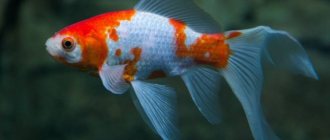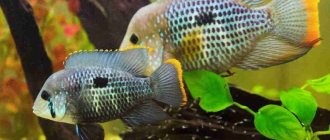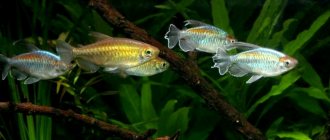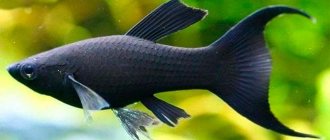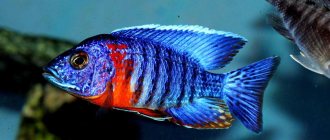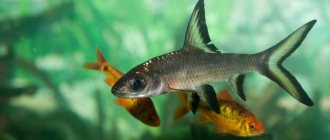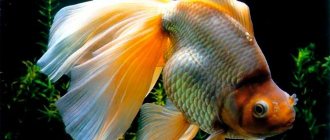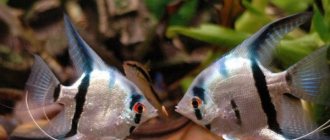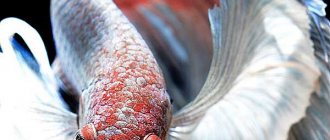Keeping in an aquarium
You need to choose a tank in which the fish will live based on their number and size.
Large individuals are kept separately from small ones in a large aquarium with a volume of about 200 liters. If there is no desire or opportunity to purchase such a large container, you can limit yourself to a smaller volume, but remember that for each fish in the aquarium there should be at least 2 liters of water. The most convenient shape of the tank is wide and rectangular, with walls not exceeding 0.7 m in height. As for water for an aquarium, it must meet several requirements:
- to be settled;
- have a temperature in the range from 21 to 26 degrees Celsius (for short-bodied fish it can be slightly higher, and for long-bodied fish it can be lower).
To maintain the habitat at optimal levels, you may need an automatic water heater and a compressor unit to oxygenate the water.
You can decorate the aquarium with plants with hard leaves (pets will eat the tender shoots)
The choice of stones, shells or driftwood must be approached with caution. Since fish can get hurt by them, it is better not to use them at all.
An aquarium with goldfish will need a compressor unit for oxygen saturation
The fish are fed twice a day at the same time with live protein food and plant foods. Sometimes you can give finely chopped vegetables and seafood, grated cereals and bread pulp. You should not get carried away with dry food from the pet store. It is very convenient to use, but with prolonged use it reduces immunity and is generally harmful to the health of pets.
You shouldn’t give too much food; it should be completely eaten within 10 minutes. If after the specified time there are food residues in the water, they must be removed.
It is impossible to keep fish alone, as they are schooling creatures and cannot stand being alone. But they do not get along well with all their neighbors. Slow species will starve in the presence of more agile competitors, and species that are too unusual in appearance (with a veiled tail or bubbles) may be maimed.
Don't give your fish too much food
Therefore, it is best to keep fish with their own kind or koi carp. If you still want to purchase different species and keep them in the same aquarium, you can try adding bots or plecostomus catfish.
Conditions for keeping goldfish in an aquarium
In terms of care, we can safely say that goldfish are not so demanding in terms of their maintenance, but the owner must still have certain knowledge to ensure the fish a comfortable existence in the aquarium.
The first thing you need to take care of if you decide to buy a goldfish is the aquarium. Since ancient times, there has been a stereotype that goldfish look very beautiful in a small aquarium, which often does not even have soil, not to mention additional equipment. This opinion is fundamentally wrong!
All goldfish have large body sizes and also like to swim in small groups or schools. Based on these facts, it is worth choosing a suitable spacious aquarium.
The best solution would be to purchase a classic rectangular aquarium with a height of 45-50cm. Please note that the volume of the aquarium must be determined in this way: 1 goldfish requires at least 50 liters of water (for large varieties).
If you plan to keep breeds with a long body (for example, a comet), then an elongated “pond” would be ideal for them, allowing the fish to actively swim.
Equipment for an aquarium with goldfish
Although goldfish are very popular, it is very difficult to call them clean fish. They eat quite a lot and produce large amounts of waste. powerful filters in the aquarium where these beautiful aquarium representatives live . It is recommended to focus specifically on external ones, which most effectively combat various types of pollution.
need as such for a thermostat for a home pond with goldfish, since they prefer cool water that does not exceed 23°C, but it protects the fish from sudden drops in temperature, so it is still worth purchasing one.
a compressor since these fish need water enriched with oxygen. Please note that in a goldfish aquarium, live plants are practically not used. Read more about the reasons below.
Lighting. Goldfish have no specific requirements for the amount of light. Modern aquarium lighting with 6000-6500K lamps perfectly focuses attention on the bright colors of fish and their movement. Excessive light in an aquarium with goldfish can lead to an outbreak of algae growth, since quite a large amount of phosphates and nitrates accumulate in the water.
Water parameters
Goldfish are quite hardy, so they can be kept in water of varying hardness. To maintain stability and cleanliness in the aquarium, about 30% of the total water volume should be changed once a week.
Decorating an aquarium with goldfish
Ground and decorations. Since goldfish were selectively bred from goldfish, they inherited some of the habits of their ancestor, namely the love of digging at the bottom in search of something edible. Therefore, the soil fraction must be large, otherwise the fish may swallow it.
In addition to this, you can add decorations in the form of driftwood, shards, castles, pots and other things to the aquarium as decoration. This will decorate the pond, and the fish will be interested in swimming between them.
Vegetation. We have already written that it is not recommended to place live plants in an aquarium with goldfish.
Vegetation does not take root, because The fish are constantly stirring up the soil. In addition, the diet of these fish is very diverse: in addition to eating animal food, goldfish are not averse to eating plants that are rich in fiber.
The types of vegetation that will not become food for goldens can be counted on one hand: echinodorus, anubias, etc., these are mainly hard-leaved species
Lifespan
The lifespan of goldfish is most dependent on the number of individuals living in one aquarium, as well as on the quality and temperature of the water.
Studies have shown that small fish live up to 5 years, medium ones - from 10 years, and large ones - up to 30. Females die earlier than males.
The record holder for the longest life in an aquarium is a fish that lived for 44 years. The body length of individuals raised in captivity is usually no more than 20 centimeters.
Goldfish are best suited for aquarists and as pets: they are easy to care for, compatible with many other fish species, and easy to breed. An individual may die without regular care, so do not neglect changing water or feeding. Aquarium fish are inexpensive.
Goldfish are sociable: they can take food from hands or swim into an open palm if they trust the owner.
How to prepare an aquarium for goldfish?!
Dimka Miller
Sorry, but you can’t keep a goldfish in such conditions (even just one! And you have several of them!) GOLDFISH IN A SMALL AQUARIUM So, you decided to opt for one or another goldfish and have already bought them a good aquarium for about 30 liters . What to do next? Give up goldfish! Or choose a different aquarium. If you simply do not have the opportunity to purchase a larger aquarium, opt for other fish. Don’t torture them and yourself, there are a huge number of other aquarium fish, no worse than gold ones, for which this container will be just a fairy-tale home. If your firm and clear choice is goldfish, you will have to spend money on a larger container. - in the photo is my 85 liter aquarium, which contained this telescope and a red cap, each the size of a palm + a pair of ancistrus (a little distorted, but the front wall of the aquarium is curved and the photo was taken on a mobile phone). PS There are round “full cycle” aquariums on sale, as well as square ones, equipped with lids and built-in equipment.
Olga Alekseeva
A round aquarium is generally not good for fish. And even more so for gold ones. They need a very large aquarium volume. The norm is approximately 100-150 liters per fish. Goldfish are difficult to care for. They are voracious and dirty. Require active filtration and aeration of water. If you are a beginner, I do not recommend getting goldfish.
Doctor
1. no round! take a regular rectangular one, because: - it does not distort the view - fish are not comfortable in a round one - there is no way to attach a filter, heater, etc. to the walls. 2. The volume for two gold coins should be 50-60 liters, taking into account the fact that no one else will be with them. 3. The aquarium should have: -coarse soil. a small golden one can swallow it or it will get stuck in the mouth when it looks for food at the bottom - a powerful filter, golden ones crap a lot - plants at will. if they are alive, then they are hard-leaved with a powerful root system so that they are not torn out. soft-leaved golden ones will eat - thermometer - no heater needed. golden ones are cold-water fish. The optimal temperature for them is 22-25 degrees. if the temperature is 20 and below, then a heater is needed. if the temperature is 28 and above, then you need to lower it, otherwise the fish will die 4. You need to feed small ones a couple of times a day, adults once a day, and once a week do a fasting day (do not feed). Any food is suitable - from simple ones like gammarus and daphnia, to more expensive ones from Tetra. but it is better, of course, to feed them live food - bloodworms. Unlike dry ones, it practically does not spoil the water. Live food is best frozen, otherwise it will spoil in the refrigerator within 2-3 days. Freeze it like this: put it in a thin layer on the bag, wrap it and put it in the freezer. When the time comes to feed the fish, you simply break off a piece and throw in gold. Goldens also need plant nutrition. This can be either plant-based dry food or aquarium plants such as hornwort and the like. 5. Once a week it is necessary to change the water. It is enough to drain 10-15% of the water volume and fill it with fresh, settled water. It is necessary to settle for at least two days, but as an option, you can use the antichlor preparation, then after adding it, water can be poured immediately. Also, as the soil becomes contaminated, it must be siphoned. The siphon can be purchased at any pet store. 6. If you decide to place neighbors next to them, then you need to calculate the volume for them as well. will not get along with them: -aggressive and cocky: barbs and cockerels (rip off the tail), cichlids (even those species that have a calm character show aggression during the spawning period) -predators (in addition to cichlids, this also applies to some species of catfish) - small fish (will be eaten) will get along: - calm ones: gourami, lalius, mollies, platies, etc. - proportionate, larger ones and those that do not fit in the mouth.
Diet of goldfish
Goldfish are quite unpretentious when it comes to food; their diet may include: bloodworms, earthworms, mixed feed, seafood, white bread, semolina and oatmeal, balls of bread and minced meat. To prevent goldfish from eating aquarium plants, you should include plant-based food such as lettuce, young nettles, and the like in their diet. As an additional feeding, the presence of Riccia or duckweed on the surface of the water in the aquarium is desirable. Goldfish do not suffer from lack of appetite, so they should not be overfed. Overeating can lead to inflammation of the gastrointestinal tract, obesity and, as a result, infertility. It is enough to feed the fish once a day, and uneaten food should be immediately removed with a siphon.
Volume and shape of the aquarium
Goldfish bred artificially in special ponds are not adapted to life in containers that are too small. An aquarium with goldfish must be at least 80 liters. With a smaller volume, the pet will not have enough space for movement and active life. By creating the most optimal housing conditions, ensuring high-quality filtration and aeration, the volume per individual can be reduced to 40 liters.
Editor's note: Astyanax - the blind fish
When choosing the shape of a container, it is preferable to choose a classic rectangular one or with a slight curvature of the front wall of the aquarium, and the length of the vessel should be at least twice the height.
The requirements for keeping an aquarium are the same as for keeping many other types of fish. The substrate should not be too fine so that the fish do not choke on its particles when digging. The particles should be smooth without sharp edges. Large decorative elements are not recommended for placement in a vessel, since golden individuals do not require a place to hide; excess decor interferes with free swimming and can be a danger to the large fins of many species.
Water parameters
Goldfish do not require special housing conditions. Her main need is space to move. Requirements for the characteristics of water inside an artificial reservoir:
- Temperatures can vary from 20 to 25 degrees.
- Acidity from 6.9 to 7.2.
- Water hardness can be no lower than 8.
The temperature of the aquatic environment can fluctuate significantly and depend on the species of individual. The golden crucian carp is cold-blooded and can tolerate low temperatures without sudden changes. Temperatures between 22–24 degrees are optimal for active games. Long-bodied individuals prefer lower temperatures than short representatives. Decorative species are considered the most heat-loving.
Filtration and water changes
A goldfish aquarium must be thoroughly cleaned due to the following factors:
- Individuals love to rummage through the substrate and pick up mud from the bottom.
- Fish excrement is a mucus that contributes to soil rotting.
To eliminate all the consequences of its life activity, you need a filter with a capacity of at least 3 volumes of water per hour.
A number of actions need to be performed:
- Wash the filter sponges in aquarium water once a week.
- Siphon the substrate once a week, being careful to prevent mixing of the layers.
- Water should be changed frequently, on average once a week.
- It is enough to let the water change stand for 24 hours.
An aerator is required, or it must be on the filter. If the internal space in the aquarium is properly organized, there are a large number of plants, sufficient lighting and an additional supply of carbon dioxide, the aerator can only be turned on at night.
Aquarium plants
Keeping goldfish in an aquarium requires the presence of live plants inside the reservoir. Plants must be present to perform a number of functions:
- Nitrogen consumption.
- Substrate for bacteria.
- Vitamin supplement for the inhabitants.
Depending on the conditions in your goldfish's habitat, there may be active algae growth. Since pets love to eat plants, it is recommended that some of the plantings be used for feeding, and some should be planted to decorate the space and create biological balance. Plants with hard leaves are better suited.
Plants should be planted in pots to protect the roots from damage during digging, which fish like to do.
Care and maintenance
Aquarium goldfish are quite undemanding when it comes to water parameters. The temperature range for comfortable existence is quite large: from 18 to 30 degrees. Changes within this interval will not cause any particular problems. However, many breeders note that in the winter-spring period it is better to maintain the temperature within 18-200C, and in the summer-autumn period 20-240C to create the most comfortable conditions.
An aquarium for goldfish must be selected at the rate of 50 liters per individual. The larger the total volume, the less free space one fish needs. But this does not mean that you can fill a huge aquarium with fish to capacity. In a volume of 150 liters you can already add not 3, but 4 fish, and already in two hundred liters 5-6 individuals will feel free.
- Goldfish love to dig in the ground , so you need to anticipate several difficulties associated with this. There will always be suspended particles present in the aquarium. Not all plants can tolerate this, because the leaves will be constantly contaminated. It is worth choosing plants with hard leaves that are unpretentious to water quality. The soil must be chosen as hard, preferably from fairly large fractions of gravel.
- Some of the water in the aquarium needs to be changed every week, and the aquarium should be washed every 2-3 months.
- For a long time, fish were bred in open ponds on the estates of nobles, so the whole breed was accustomed to a sufficient amount of oxygen. It is worth taking care of good aeration of aquariums.
- Goldfish need salt. They can easily tolerate unsalted water, but if their health worsens, it is better to add salt to the aquarium at the rate of 2 teaspoons per 1 liter of water.
Varieties
The most common natural color of goldfish is red-gold, with darker hues on the back. They can be of other colors: pale pink, fiery red, yellow, red, white, black, dark bronze, black and blue.
Comet
This goldfish is characterized by its simplicity and unpretentiousness
. She herself is small in size with a long tail, larger than her body.
The standard of beauty for a comet is considered to be a fish with a silvery body and a red, bright red or lemon-yellow tail, which is four times the length of the body.
Veiltail
This is an artificially bred variety of goldfish. Its body and head are rounded, its tail is very long (four times longer than the body), forked and transparent.
This species is very sensitive to sudden changes in water temperature. When the temperature is unfavorable for them, they begin to fall to one side, float upside down or sideways.
fantail
This fish can easily be confused with a veiltail
because they are very similar. The difference is that the fantail's body is slightly swollen on the sides, while the veiltail's fin is higher.
The tail of this fantail consists of three blades that are fused together. Its unusual beauty is given by its color: red-orange body and fins, with a translucent edging along the outer edge of the fins.
Telescope
Telescope or Demekin (water dragon). It has a swollen ovoid body and a vertical fin at the back. All its fins are long
. Telescopes differ in the shape and length of the fins, the presence or absence of scales, and color.
- The calico telescope is multi-colored. Its body and fins are covered with small spots.
- The Chinese telescope has a body and fins similar to a fantail. He has large bulging spherical eyes.
- Black telescopes were developed by a Moscow aquarist. This is a fish with black velvet scales and ruby red eyes.
general description
Goldfish come with some more or less significant differences from each other. For example, with a long, laterally compressed or rounded body. Interestingly, body shape is associated with life expectancy. Round fish live only 15 years, while elongated fish live as long as 40. They grow from 15 to 45 cm in length.
Some representatives have large scales, while others have small ones and are even absent in some areas. All have large gill covers, pharyngeal teeth, hard serrations on the rays that form the fins, and large eyes with varying degrees of protuberance.
Depending on the breed, fish vary in color. It can be represented in shades of red, pink, bronze, yellow, blue and even black. A feature of all fish of this species is a lighter belly compared to the main color.
There are different types of goldfish and the shape of their swimming organs. Some representatives have a regular forked tail, while others have it long and flowing like a veil. The same goes for fins.
Zoological portrait
The aquarium fish we know as goldfish are officially named Carassius auratus auratus (in Latin) and belong to the cyprinidae family. The closest relatives of goldfish in our rivers and lakes are mirror carp, crucian carp, bream, rudd and bleak. But it’s difficult to say which family the Pushkin Golden Fish belonged to, because these fish are predominantly freshwater.
In a home aquarium, goldfish, as a rule, do not grow longer than fifteen centimeters, although they can reach thirty centimeters in length. They have a laterally flattened elongated body of an elliptical shape with a sharp snout (muzzle). The long upper (dorsal) fin begins in the middle of the body, and the short lower (anal) fin is located closer to the tail. The classic coloring of a goldfish is red-gold on the back, yellow-gold on the sides and yellowish on the belly. The fins are painted bright red or any reddish shades, less often they are simply yellow. However, there are specimens of simply exotic colors, ranging from black and blue to white. So the goldfish may not be golden at all, but red, pink, brown or even spotted.
It is possible to determine the gender of a goldfish only in the pre-spawning period. At this time, males, ready for spawning, acquire a distinctive feature - notches located on the front ray of the first pectoral fins and on the gills. A female ready to lay eggs can be easily recognized by her compact, swollen abdomen. If you look at the fish from above during this period, you will notice a curvature of the body, which often remains after the eggs are laid.
An aquarium with goldfish must meet the conditions that are comfortable for them. It is advisable to purchase a special species aquarium with a length of one meter. It is necessary to pour coarse soil onto the bottom of the aquarium and plant a small number of aquatic plants. In accordance with the conditions for keeping goldfish, these should be plants with not very small leaves, such as egg capsule or vallisneria. It is good to place floating plants in the aquarium, which serve as food for goldfish. Of the floating plants, duckweed and riccia are the most suitable.
Comfortable living conditions include water whose temperature ranges from 16 to 24 degrees. Moreover, in winter the water temperature should not exceed 20 degrees, and in summer it should drop below 21. It is necessary to gradually reduce or increase the seasonal water temperature.
Proper care of goldfish also means maintaining a balance of hardness and acidity of the water in the aquarium. Water hardness (dH) for goldfish can range from eight to eighteen units, and acidity (pH) is maintained around seven units. The water in the aquarium, naturally, must be clean and saturated with oxygen, and the height of its layer should not be less than twenty-five centimeters. Caring for goldfish also involves daily water renewal, when one tenth of its total volume is added to the aquarium. It is necessary to add water of the same composition and temperature, and with seasonal temperature changes, increase and decrease the degree using daily water updates. It is also advisable to equip the aquarium with a filter and an aerator.
Editorial: Paracyprichromis nigripinnis
The maximum permissible number of fish in an aquarium can be determined using a simple formula: for every ten centimeters of fish body length, two hundred square centimeters of water surface is required. For an aquarium without aeration, this norm is doubled. And at the same time, daily water replacement should be at least a third of the total volume. Note that it is much easier to care for fewer fish.
What to feed in the aquarium?
Goldfish are always ready to eat, but this is not a reason to feed them. Feeding is done in the morning and evening. The weight of the feed should be no more than three hundredths of the body weight of the fish. In this case, it is better to remove the remaining food from the aquarium.
The main difficulty in keeping goldfish in an aquarium is their diet. It is better to underfeed the fish than to overdo it. A hunger strike is easily tolerated by this species, while overeating will lead to health problems.
Goldfish require a combination of dry and live food. It is better to soak dry food in water half an hour before feeding.
In the diet you can use:
- specialized feeds,
- finely chopped lettuce and grated carrots,
- duckweed and naiad.
Small bloodworms, earthworms or tubifex can be used as live food. They contain a large amount of protein, which will be beneficial for aquarium inhabitants.
For additional feeding, you can use chopped shrimp, squid and fish fillets.
Dry fish food
Water eyes (bubble eyes)
Bred by the Chinese, it has a short head and a small nose. The round body of the fish can reach 18 cm and has different colors. The most common colors are silver, brown and orange. The main distinguishing feature is large, forward-looking eyes with hypertrophied periocular vesicles. They are filled with water and can make up almost a quarter of the body length. There is no dorsal fin; there is a bifurcation of the caudal and anal fins. The tail blades puff up and do not hang down.
The container is chosen to be 50 liters in size per eyeball, kept under the following conditions:
- water hardness - no more than 20°;
- temperature - 12–28 °C;
- acidity - 6.5–8 pH.
Important! The design of the aquarium where bubble eyes live should be free of driftwood and other decorations with sharp corners that could damage the bubble around the eye.
It happens that, despite all the precautions, this fish still damages them and they are blown away. With good care, blisters can recover and inflate again.
With good care, the blisters can recover and inflate again.
The most popular variety of goldfish
Goldfish are a subspecies of silver crucian carp. In the wild, they live in Korea, China, Japan and the islands of Asia.
Varieties of goldfish
Today you can choose any type of goldfish for your aquarium according to your own taste. And they are available to everyone. In general, all fish of this large species can be divided into short-bodied and long-bodied. Let's look at the brightest and most common representatives.
A variety of goldfish with a special tail in the shape of butterfly wings, open for flight, is called a butterfly. But fantail fish have a train-like tail, which is raised upward and is divided into 2, 3 or 4 parts. It can take a position similar in appearance to a fan.
The next variety of goldfish is the lionhead. The head of representatives of this species is covered with growths similar to strawberries, and together with the rounded body, it resembles the head of a lion. The oranda is distinguished by large growths between the eyes, and the ryukina has a hunchbacked back.
Many varieties of aquarium goldfish have mutated, changing the shape of their eyes. For example, the fish, which is called the “sky eye”, constantly looks up, and the fish “water eyes” has impressive eyes and eye bubbles with liquid. The telescope, veil telescope and black telescope are characterized by very large eyes.
The varieties of goldfish, photos of which you see, also differ in body shape. A comet has a long tail, often longer than the body itself. Ranchu lacks a dorsal fin, but has growths on its head. Shubunkins are noticeable by their calico color and transparent scales.
And finally, an ordinary goldfish has a medium-sized body and elongated fins. Its color can be red, red-golden and red-white.
Compatibility
Fish that differ in size or body length also have their own temperament, so it is better to house them separately. Long-bodied representatives (shubunkins, comets) can grow quite large, so for them you should take an aquarium of at least 200 liters. However, they are unpretentious and very hardy.
Stargazers, telescopes and water-eye fish need to be housed separately. Clumsy and slow telescopes risk not being in time for food distribution and remaining hungry.
The water-eye fish is easily injured. But the most unpretentious ones can be called ryukins and fantails. It is with the maintenance of these species that beginner aquarists can begin.
fb.ru>
Main breeds of goldfish
Over thousands of years of painstaking breeding work, amateurs and fish breeders in Japan, China and other countries have developed many breeds, as well as variational varieties of goldfish.
Conventionally, all breeds can be divided into two types depending on body shape:
- long-bodied;
- short-bodied.
In total, several dozen are known (and according to some data, about 300 variations of breeds).
Here are examples of some of them:
Common goldfish (Carassius auratusm) - the body shape and fins follow the natural shape of the fish. They can grow up to 30 cm.
Butterfly (Goldfish Butterfly tail) - distinguished by the unusual color of forged non-ferrous metal, as well as a forked tail, the shape of which follows the wings of a butterfly. Reaches a size of up to 10 cm.
Fantail - distinguished by a raised upward or horizontal short tail, which when opened resembles a fan.
The veiltail is one of the artificially cultivated ornamental breeds of the aquarium “goldfish” (lat. Carassius gibelio forma auratus), which is known for its elongated fins and a longer, bushier veil tail - compared to other representatives of this species. Reaches sizes up to 20 cm.
Comet (Goldfish Comet) - has an elongated body and a tail fin in the form of a forked ribbon. The longer the fin of an individual fish, the more valuable it is. The average size of the fish is 10 cm.
Goldfish Bubble Eye An unusual breed that has a forked tail, as well as two bubbles hanging on the sides under the eyes, filled with liquid. The blisters can be up to ¼ the size of the body. When kept in an aquarium, the liquid bags may burst. The bags recover over time, but may vary in size. The fish can reach 13 cm, life expectancy up to 15 years.
Redcap Oranda Goldfish Has a white body and a characteristic bright red warty growth on the top of the head. The growth begins to form at 3-4 months of life, reaching its maximum size by 2 years. It is worth remembering that this breed is sensitive to temperature and water quality. The size of the aquarium fish is 15-20 cm.
Nymph (Fantail Goldfish) This breed of fish is often found in various exhibitions. A distinctive feature is the large caudal fin. The most valuable individuals have a “decoration” in the form of a forked tail. Most often, the fish are red-orange in color. The nymph is quite unpretentious in care; it can be kept in an aquarium, and in summer in open decorative ponds. The average size of fish in an aquarium is 10 -15 cm.
Lionhead Goldfish Has a rounded short body. Most of the fish’s head, sometimes the eyes, mouth and nostrils, are decorated with growths. Representatives of this species can have black, blue, red colors in numerous combinations. It is worth considering that this fish is quite slow; you should not place it next to active “neighbors” who can easily leave it without food. In an aquarium it reaches a size of up to 13 cm.
Ranchu (Ranchu Goldfish) Popular in Japan and China. It has a short rounded body, a wide back, strongly curved towards the tail. The classic coloration is a white body with specks, as well as red head growths. Due to the head tubercles resembling a raspberry, this breed is similar to the lionhead. Due to the unusual body shape, the fish cannot actively swim in the water column, so you should not choose active related breeds as “cohabitants”. It is best to keep the fish in an aquarium; in artificial ponds it may simply not survive due to low temperatures.
Ryukin Goldfish Considered to be the Japanese version of the Nymph. Both fish are bred from a common ancestor, but this variety has a high back, often called a hump. It starts at the neck area, thereby giving a tapered appearance when viewed from the side. The body itself is short, round in shape, the caudal fin is divided in two. There is a variant with very long fins called the Long-tailed Ryukin. The color can be different, monochromatic - red, orange, white, as well as a combination of several colors. For example, white coloration with numerous irregular spots of orange, red or brown is widespread. Reaches sizes up to 15 cm. They live 10-15 years.
Goldfish "Oranda"
A popular goldfish prized for its bizarre growths on its head. By the way, if the “cap” has grown too much and prevents the fish from seeing, then it can be trimmed, since the growth does not have nerve endings.
“Little Red Riding Hood” is the most popular “Oranda”. Lyudmila Svetlitskaya
The most famous and beloved variety of the breed is the “Little Red Riding Hood” fish with a characteristic red growth that stands out against the background of a pure white body. Another characteristic color is a bright orange body and a black stripe on the upper part of the body. But in fact, the color of the “Oranda” is represented by almost all the colors of the rainbow.
The body is oval, slightly oblong. The tail can be ribbon, veil or fan-shaped. "Orandas" are distinguished by a very calm character, they are always friendly to their neighbors. In this regard, the breed is considered the kindest of all types of goldfish. However, the Oranda is the largest of all the fancy breeds, as its size can reach more than 30 centimeters.
Oranda varieties such as “Tigerhead” and “Lionhead” also have a similar appearance to “Little Red Riding Hood”. They differ from the first one mainly in the shape and location of the growth.
Advantages of the Oranda breed:
- playful but calm disposition;
- relative unpretentiousness.
Disadvantages of the Oranda breed:
- the head growth can be affected by fungal diseases;
- very large size as an adult.
Species, description and habitats
As a result of long selection, more than 300 breeds were developed. Among them there are a variety of shapes and colors. It is difficult to even suspect many of them as being related to Chinese crucian carp. The homeland of the aquarium goldfish is China, which is why many forms give off some strangeness and elegance of the ancient country.
The common goldfish has changed little over the years. Even today it has forms close to the Chinese crucian carp: a flat body without visible bulges, a small (no more than 10 cm) tail, rounded fins and an orange, non-flashy color. It was with these fish that the breeding began.
China
They can be kept both in an aquarium and in open water. Depending on the conditions, the color may vary slightly. In a pond, the fish can grow up to 30-45 cm, excluding the tail. In an aquarium, sizes rarely exceed 10 cm.
Every breed has distinctive characteristics. For goldfish, this is the size of the eyes, the shape of the fins and the lighter scales on the abdomen. Coloring is not considered a breed characteristic. It seems strange, but the color of different species ranges from bright orange to a dark copper, almost purplish color. In such species it is not always possible to distinguish golden shades of color.
Other signs also vary: various growths on the head, shape of the tail and protrusion of the eyes. Even the most picky aquarist will be able to find a fish to his liking.
In addition to the ordinary goldfish, there are a number of specific varieties that are distinguished by unusual shapes and often have special requirements for their content:
- One of the most unusual and popular is the Butterfly Tail . This is an exclusively aquarium fish of copper colors with bulging eyes and a tail branched in different directions, which is very reminiscent of the wings of a butterfly, while the tail often reaches the size of the body. The fish is distinguished by its love of cool water and is extremely loved by aquarists.
- The lionhead has gone even further from its original appearance . This fish has characteristically rounded sides, which make its small 15 cm body look like a chicken egg. This species is nicknamed the lionhead for its characteristic red growths that look like a lion’s mane and cover the entire head except the eyes. The scales are large in size, and the colors vary within three colors: orange, red and white. Orange-colored fish are more common.
- -Eyes breed has a special charm . This species has large blistering growths around its eyes. They require special treatment and thoughtful selection of tankmates, since the bubbles are very easy to damage.
Bubble-eye goldfish
Tips for choosing your first fish
Avoid fish with a specific diet - as a rule, food is the main source of problems in the aquarium. For the first 6-8 months, you need fish that will suffice with regular food - flakes, for example. After six months, the diet can be improved and diversified with as wide a range of foods as possible.
Don't buy too many fish at once. Although an aquarium with several fish does not look very spectacular, try to add fish slowly without risking losing them all at once to disease, for example. A rough rule of thumb is no more than six small fish per week.
Ask the store how long the fish have been kept in the display aquarium. It is better not to take newly added ones, two transplants in a short period of time are too much stress and can lead to problems.
- Find an aquarist you know to give you advice.
- Google about fish before you buy it.
- Don't buy on impulse
- Always know exactly how big your fish grows to
- Write a list of fish you want now and in the future
- Find out the water parameters in your aquarium
- Remember, adult fish can change dramatically
- Avoid deformed and artificially bred fish
- Make sure that the conditions in the aquarium are suitable for your future pets
- Don't buy too many fish
Popular fish such as guppies or neons are actually not the only option for beginners
In order to choose the right aquarium fish, it is important to understand the difference between one that will take root well in a new aquarium and one that will get sick.
Goldfish "Veiltail"
The same goldfish from Pushkin’s fairy tale with a luxurious long tail has the appearance of a classic veil tail. Their fins are so long that they can even stretch along the bottom of the aquarium. According to the breed standard, their tail should be at least twice as long as their body and completely separated from the beginning to the very tip. Such a luxurious tail fin elegantly trails behind the fish like a train.
Editor's note: Astyanax - the blind fish
The luxurious tail fin elegantly trails behind the Veiltail goldfish like a train. um-yesplease-photography
The fin blades have a characteristic rectangular shape. Adding additional attractiveness is the very high dorsal fin, reminiscent of a boat sail (ideally it should be as high as the body, without bending to the side). The body of veil-tailed goldfish has a compact ovoid shape.
“Veil tails” require special attention, since their rich fins can not only be easily damaged by the decoration of the aquarium, but are also actively pinched off by their fellows. By nature, these fish are balanced and leisurely, and many owners describe the veiltail as a “good-natured and gentle” fish. In adulthood, it reaches 20 centimeters in length, not counting the tail.
Advantages of the Veiltail breed:
- fabulous appearance;
- calm disposition.
Disadvantages of the Veiltail breed:
- swims slowly, has difficulty competing for food;
- the caudal fin is easily damaged;
- prone to fungal and parasitic infections.
Be careful with deformed species
A careful study of the fish that you liked at first sight may surprise you. For example, when buying a three-hybrid parrot for the first time, few people know that it is the result of artificial selection of three different species of fish. And that its unusual shape is the result of deformation of bones and internal organs. If they had known, they might have refrained from purchasing.
Now there are many fish of unusual shapes and colors. But, often, this is all the result of selection and intervention in nature. Deformed skeleton, organs and low immunity are the result of the intervention. Avoid these types of fish at the initial stage.
Also, avoid fish that appear too bright in color. Unscrupulous sellers specifically stimulate the fish before selling them, but being in the cramped and bustling market is stressful for the fish. And usually she reacts to it by becoming less bright than in the aquarium, and not vice versa.
The fish grow as much as the aquarium allows, but at the same time they have deformed internal organs and health problems. As a result, the skeleton becomes crooked, the immune system practically disappears, and instead of a beautiful fish, you get a crooked monster
Most fish will grow to their maximum size, perhaps a little less than in a large aquarium. For example, the shark baloo, which grows up to 30 cm, can grow up to 25 cm in a small volume.
Goldfish habitat
In nature, the closest relatives of goldfish originally lived in China. Later they spread to Indochina and then to Japan. Then, with the help of merchants, they ended up in Europe, and then in Russia.
In quiet Chinese provinces, fish lived in slow-moving rivers, lakes and ponds. People breeding crucian carp in their reservoirs began to notice that some fish were yellow or red in color, and chose them for further selection.
Later, such crucian carp were kept in vats in the houses of rich and noble people. So, we can say that the goldfish simply does not have a natural habitat. This variety was bred and selected artificially.
A little history
By the beginning of the 16th century, goldfish spread to Indochina and took root as beloved pets in Japan; these exotic aquarium inhabitants appealed to the Japanese with their love of beauty and harmony.
Around the same time, Dutch and Portuguese merchants also brought goldfish to Europe. By the 18th century, these exquisite pets gained great popularity and spread throughout Europe.
Caravan routes connected East and West, Asia and Europe, and passed through Russia. The Great Silk Road contributed to the active exchange of goods between the countries of the East and Russia; treats and oriental silk fabrics were transported along it; quite soon, unusually expensive goldfish, unusual for those times, were brought to Russia. Chronicle memories of exotic offerings can be found already in the 15th century, during the time of Vasily the Dark. Ivan the Terrible also received exquisite gifts from foreign envoys - glass balls with goldfish were brought from overseas countries.
In the 17th century, during the reign of Alexei Mikhailovich, goldfish swam in an exquisite vase and decorated the Apothecary Garden. Such an expensive gift was received from the British, and court fish breeders were specially hired to care for the unusual pets.
During the time of Peter I, some courtiers acquired unusually expensive and fashionable vessels with exotic fish In 1790, Grigory Potemkin specially organized an evening in honor of Catherine II and presented at this meeting goldfish - a wonder of fabulous price, according to the ideas of those times.
Goldfish were brought to the USA around 1874-78, and the imported specimens became the basis for the future collection of the Washington State Nursery.
How long do aquarium fish live?
Every aquarist wonders how long aquarium fish live. Everyone needs to know this. If you are not sure that you want to keep the aquarium for a long time, get fish with a short life expectancy
For experienced breeders, the number of years is important for calculating the spawning times that the fish will have time to complete.
Several points can affect the lifespan of aquarium inhabitants:
- Size;
- Water temperature;
- Overfeeding;
- Underfeeding;
- Conditions of detention;
- Neighborhood.
Fish size
The main criterion is the size of the fish. By this indicator you can judge how long you can admire your pet in the aquarium. The lowest limit is for small inhabitants, whose size does not exceed 5 centimeters. For example, neon, guppy, swordtail. They live from one to five years.
Record small sizes were found in a South American fish - cinolebias. Its lifespan depended on the rainy season; as soon as drought occurred, cinolebias died. The only thing that saved the fish from extinction was timely spawning. During the period of high water, she managed to appear, grow, spawn and die.
Fish whose size is defined as medium can live up to 15 years, and some representatives over 25, for example, piranha. Therefore, when getting such pets, be prepared for a long relationship.
An interesting fact is that males live much longer than females. Sometimes the difference reaches almost two years. There are breeds where the female dies after giving birth to the fry. Of course, no one is immune from unsuccessful spawning or a number of diseases, but most often this is observed in swordtails and gupeshkas.
Aquarium water temperature
The lifespan is affected by the temperature of the water in the aquarium. Cold-blooded animals cannot control their body temperature on their own, so water sets the rhythm for most processes occurring in the body. The body temperature of the fish is equal to degrees of water. Thus, the higher the indicator, the more intense metabolic processes occur in the fish’s body, and, therefore, life expectancy is reduced. Sometimes this figure reaches several years.
It has been proven that if you rarely change aquarium water, the concentration of harmful substances in the water will be higher than normal, which will entail a reduction in the life of the inhabitants. Use settled water, the chlorine content of which is close to the permissible value. Bad water can lead to dysfunction of the respiratory organs and diseases of the digestive organs.
Diet
How long aquarium fish live is affected by food. We will talk about overfeeding and underfeeding. Fish obesity is a fairly common problem. Most often this happens in families with small children who are interested in watching the inhabitants of the aquarium eating food. Don't underestimate underfeeding. Due to a deficiency of nutrients and vitamins, they will not have enough energy for normal existence. If you are unsure about the correct amount of food, sniff the water. If you overfeed the fish, the water will have a specific smell. Ideally, there should be no aromas coming from it.
Overfeeding occurs if:
- The water has a rotten smell;
- It becomes cloudy quickly;
- A film forms;
- Algae has a slippery coating.
To avoid the death of your favorite fish and increase the number of years of being together, it is necessary to observe moderation in feeding, then life expectancy will correspond to the figure indicated in reliable sources. There should be enough food so that the fish have time to eat it within a few minutes after the food is served.
